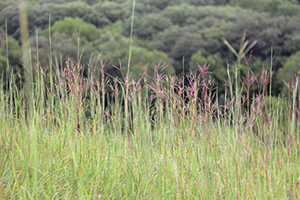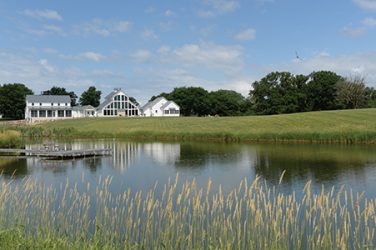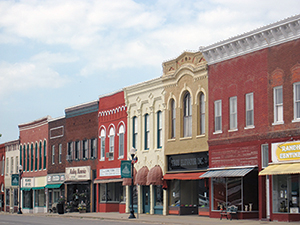Above: Towering big bluestem, once the monarch of prairie plants, still stretches leisurely upward and waves from the bluffs of Five Ridge Prairie State Preserve in Plymouth County.
Writer and Photographer: Kelly Norris
The tallgrass prairie has been the subject of both literary praise and disdain, a curious blend of romanticism and animosity toward the nearly 170 million acres of grassland that once covered the midcontinent. Charles Dickens, traveling across the prairie, famously recounted the landscape as “oppressive in its barren monotony.” John Madson, the Iowa-born father of the prairie restoration movement, described his curious love for the biome in the conclusion of his book “Where the Sky Began” as that of a “modern man fallen in love with the face in a faded tintype.”
But suspend nostalgia if you will. While only one-tenth of 1 percent of those original acres remain today, the wealth of prairie biodiversity is a treasure worth saving and sharing. Tucked away in unarable quarters often by good-hearted conservationists, parcels of Iowa’s natural heritage thrive in the public trust. Here are three preserves and the plants worth experiencing as you hike your way to a greater awareness of Iowa’s yesterday and today.
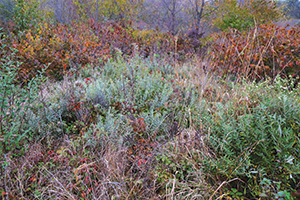 Reichelt Unit, Rock Creek State Park
Reichelt Unit, Rock Creek State Park
The Reichelt (pronounced rye-shelt) Unit of Rock Creek State Park has a history of best intentions now encroached upon by invasive woody plants like Russian olive and Tatarian honeysuckle. In the early 1980s, farmer and fishery owner Sherman Reichelt donated the 444-acre property to the Iowa Natural Resource Commission. Bureaucratic conditions placed on the transfer all but guaranteed little public management of the land until 2007 when oversight was transferred to nearby Rock Creek State Park.
While by no means virginal, a high-quality dry-side prairie remnant drapes across three ridges in the preserve’s extreme northwest corner. Despite an overall lack of fire in the last 30 years, more than 100 species of prairie natives occur on this site, including prairie willow, an unexpected, ground-hugging species (not a tree with weeping branches). Interloping through dense stands of little bluestem, these gray and sinuous stems are a cool counterpoint to the fiery shades of the autumn landscape.
The Reichelt Unit is located eight miles west of Grinnell on the south side of U.S. Highway 6. More information: 641.236.3722; Rock_Creek@dnr.iowa.gov
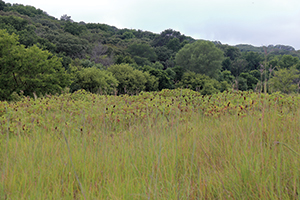 Five Ridge Prairie State Preserve
Five Ridge Prairie State Preserve
There’s a certain crackling sound that dried prairie grasses make when they take flame. The roar of that thermodynamic force across the wind-worn ridges of the Loess Hills must have reached unfathomable crescendos. But 25,000 years ago these flames burned hot on a nearly annual basis, an ecological version of creative destructionism.
In the ashes of disturbance, hundreds of species of flowering plants thrived by adapting to the rigorous reality of the midcontinent, a turbulent struggle between the subtropical flirtations of summer and the subarctic plunges of winter. Big bluestem thrived in this context, a westward easterner that proliferated across the Midwest, perhaps the single most populous plant on the continent at the peak of its existence.
Today, the plant’s familiar turkey-footed flowering stalks reach skyward—6-foot-tall reminders of Iowa’s natural history—alongside trails that snake and squirrel their way through oak-lined valleys and grassy bluffs of the 964-acre preserve in western Plymouth County. Amid this weft of late summer stems, purple prairie clover and stiff sunflower speckle the landscape with magenta and gold.
The preserve is located seven miles south of Westfield on the east side of Iowa Highway 12. More information: 712.947.4270; plymouthcountyparks.com
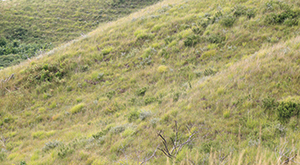 Preparation Canyon Unit, Loess Hills State Forest
Preparation Canyon Unit, Loess Hills State Forest
The tallgrass prairie in its finest condition is a matrix and mosaic of plants, laid onto one another in seasonal layers. Walk across the narrow hilltop adjacent to the Loess Hills Scenic Overlook in west-central Harrison County at any point of the summer and you’ll find dozens of wildflowers randomly knit into the fabric of short grasses that mitigate erosion of the friable loess underneath.
Silvery among them is leadplant, the shrubby forb that pioneers erroneously believed was a predictor of iron deposits (imagine the effort exercised against interminable prairie loam in pursuit of such a myth). For all that it wasn’t, leadplant is a contemporary linchpin of high-quality prairie remnants to the benefit of long- and short-tongued bees. A handful of bees prefer only pollen from leadplant, a preferential inclination scientists refer to as oligolecty (worthwhile “Jeopardy” knowledge). It’s also the preferred forage for livestock, deer and other herbivores; gardeners with native inclinations, take note.
The 4,125-acre Preparation Canyon Unit is located near Pisgah and stretches north of town for almost eight miles. More information: 712.456.2924; iowadnr.gov/Places-to-Go/State-Forests/Loess-Hills-State-Forest


